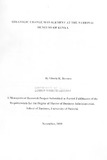| dc.contributor.author | Borona,Gloria K | |
| dc.date.accessioned | 2013-05-15T07:19:39Z | |
| dc.date.available | 2013-05-15T07:19:39Z | |
| dc.date.issued | 2009 | |
| dc.identifier.citation | Masters of business administration | en |
| dc.identifier.uri | http://erepository.uonbi.ac.ke:8080/xmlui/handle/123456789/22879 | |
| dc.description.abstract | With the rapid changes in technology and globalization the past decade has seen
organizations of all types undergo change more than ever before. Change management
entails thoughtful planning. sensitive implementation and above all consultation and
involvement of the people affected by the changes. If you force change on people
normally problems arise. Change must be realistic. achievable and measurable.
Change can take many forms and include many environments. The most common IS
organizational change management which is the process of developing a planned
approach to change in an organization. Typically the objective is to maximize the
collective benefits for all people involved in the change and minimize the risk or failure
in implementing the change. To be effective, change management should be multidisciplinary
and should touch on all aspects of the organization. At its core. implementing
new procedures. technologies and overcoming resistance to change are fundamentally
human resource management issues which determine the success or failure or a change
program.
The National Museums of Kenya (NMK) is a unique institution that manages three
World Heritage Sites, twenty two museums and over a hundred sites and monuments
across the country. As the custodian of Kenya's natural and cultural heritage. NMK
collects preserves and presents the past and present for today and posterity. Like other
institutions operating in a competitive global environment the institution saw the need to
undertake a change management process. To this end the museum underwent a
restructuring program from 2005 to 2007 with an aim of making it a world class
institution which is responsive to visitor needs.
This case looks at the forces of change within the NMK, strategic change management
practices adopted, the change content and the challenges faced in implementing the
change program. The study identified that some of the change programs were still
ongoing and recommends that the NMK develops the capacity to be a learning
organization that is able to respond to changes in the environment and move into the
future sustainability. | en |
| dc.description.sponsorship | University of Nairobi | en |
| dc.language.iso | en | en |
| dc.title | Strategic change management at the national museums of Kenya | en |
| dc.type | Thesis | en |
| local.publisher | School of business,University of Nairobi | en |

